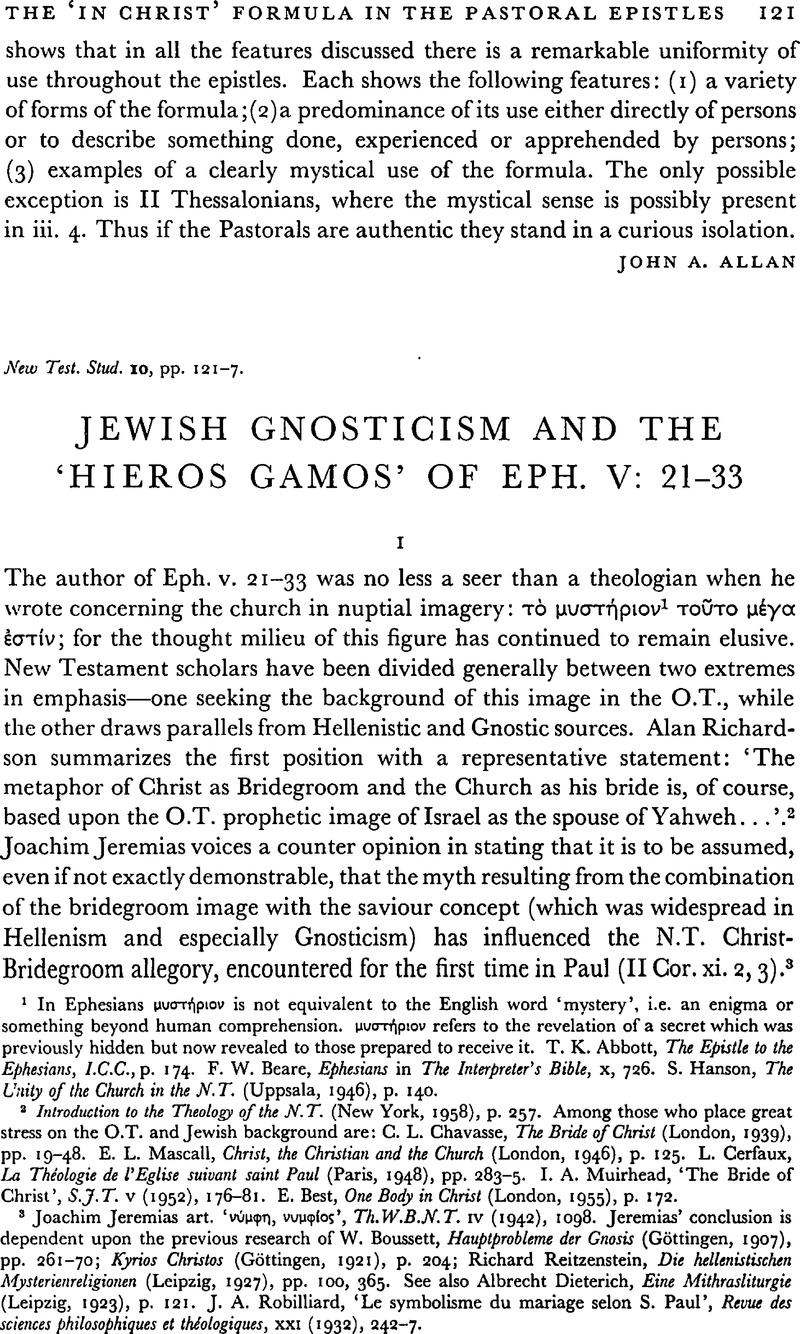No CrossRef data available.
Published online by Cambridge University Press: 05 February 2009

page 121 note 1 In Ephesians μυστήριον is not equivalent to the English word ‘mystery’, i.e. an enigma or something beyond human comprehension. μυστήριον refers to the revelation of a secret which was previously hidden but now revealed to those prepared to receive it. T. K. Abbott, The Epistle to the Ephesians, I.C.C., p. 174. F. W. Beare, Ephesians in The Interpreter's Bible, x, 726. S. Hanson, The Unity of the Church in the N.T. (Uppsala, 1946), p. 140.
page 121 note 2 Introduction to the Theology of the N.T. (New York, 1958), p. 257. Among those who place great stress on the O.T. and Jewish background are: C. L. Chavasse, The Bride of Christ (London, 1939), pp. 19–48. E. L. Maseall, Christ, the Christian and the Church (London, 1946), p. 125. L. Cerfaux, La Théologie de l'Eglise suivant saint Paul (Paris, 1948), pp. 283–5. I. A. Muirhead, ‘The Bride of Christ’, S.J.T. v (1952), 176–81. E. Best, One Body in Christ (London, 1955), p. 172.
page 121 note 3 Joachim Jeremias art. ‘νυμφη, νυμφίος’, Th.W.B.N.T. iv (1942), 1098. Jeremias' conclusion is dependent upon the previous research of W. Boussett, Hauptprobleme der Gnosis (Göttingen, 1907), pp. 261–70; Kyrios Christos (Göttingen, 1921), p. 204; Richard Reitzenstein, Die hellenistischen Mysterienreligionen (Leipzig, 1927), pp. 100, 365. See also Albrecht Dieterich, Eine Mithrasliturgie (Leipzig, 1923), p. 121. J. A. Robilliard, ‘Le symbolisme du manage selon S. Paul’, Revue des sciences philosophiques et théologiques, xxi (1932), 242–7.
page 122 note 1 Der Brief an die Epheser (Düsseldorf, 1957), p. 275. ‘So sehen wir: die Vorstellungen, die den Hintergrund von Eph. 5, 22 ff. abgeben können, sind überaus vielfältig, mehr oder weniger ausgebildet, weitverbreitet, überschreiten die an sich noch labilen Grenzen zwischen kirchlichen und häretischen Schriften und reichen von der Mitte des i. Jahrhunderts v. Chr. bis in die zweite Hälfte des 2. Jahrhunderts. Sie kommen meist aus dem Umkreis einer mit einem hellenisierten Judentum zusammenhängenden “Gnosis”’. Another good but less comprehensive treatment of the Jewish and Hellenistic background to the N.T. nuptial imagery has been worked through by Hans Windisch, Der zweite Korintherbrief (Göttingen, 1924), pp. 320–2.
page 122 note 2 For the critical text of Baruch see Walter Volker, Quellen zur Geschichte der christlichen Gnosis (Tübingen, 1932), pp. 27–33. Cf. Robert M. Grant, Gnosticism (New York, 1961), pp. 93–100.
page 122 note 3 ‘Das Buch Baruch’, Z.Theol. Kirche, L (1953), 131–41. So C. H. Dodd, The Interpretation of the Fourth Gospel (Cambridge, 1953), p. 99.
page 122 note 4 ‘Gnosis Revisited’, Church History, xxiii (1954), 37. Cf. Gnosticism and Early Christianity (New York, 1959), pp. 19–26.Google Scholar
page 122 note 5 See Hermann Diels, Die Fragmente der Vorsokratiker (Berlin, 1912), 11, 198–200. Eugene de Faye detects faint echoes from the Platonic myth of Phaedrus but maintains that Justin owes much more to the O.T. than to philosophy. Gnostigues et Gnosticisme (Paris, 1925), p. 241.
page 122 note 6 Cf. Wilson, Robert M., The Gnostic Problem(London, 1958), p. 122.Google Scholar
page 123 note 1 Hans Leisegang, Die Gnosis (Stuttgart, 1955), p. 166.
page 125 note 1 See the discussion of ‘Die Syzygienlehre’ in Hans-Joachim Schopes, Urgemeinde judenchristentum Gnosis (Tübingen, 1956), pp. 56–61.
page 125 note 2 Bornkamm, G., art. ‘μνστήριον’, Th.W.B.N.T. iv (1942), 829.Google Scholar
page 126 note 1 Smidt, Karl L., The Church, trans. Coates, J. R. (London, 1950), p. 18. Schmidt considers this world of ideas to be akin to Valentinian Gnosis and the Odes of Solomon.Google Scholar
page 126 note 2 Primitive Christianity (New York, 1956), p. 162. See also Robert M. Wilson, ‘Recent Studies in Gnosticism’, N.T.S. vi (1959), 34. ‘Gnostic Origins’, Vigiliae Christianae, ix (1955), 193–211. ‘Gnostic Origins Again’, Vigiliae Christianae, xi (1957), 93–110.